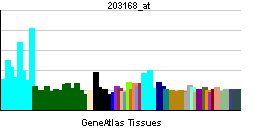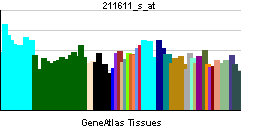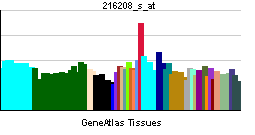CREBL1
| CAMP responsive element binding protein-like 1 | |||||||||||
|---|---|---|---|---|---|---|---|---|---|---|---|
| Identifiers | |||||||||||
| Symbols | CREBL1 ; CREB-RP; FLJ10066; G13 | ||||||||||
| External IDs | Template:OMIM5 Template:MGI HomoloGene: 31238 | ||||||||||
| |||||||||||
| RNA expression pattern | |||||||||||
 | |||||||||||
 | |||||||||||
 | |||||||||||
| More reference expression data | |||||||||||
| Orthologs | |||||||||||
| Template:GNF Ortholog box | |||||||||||
| Species | Human | Mouse | |||||||||
| Entrez | n/a | n/a | |||||||||
| Ensembl | n/a | n/a | |||||||||
| UniProt | n/a | n/a | |||||||||
| RefSeq (mRNA) | n/a | n/a | |||||||||
| RefSeq (protein) | n/a | n/a | |||||||||
| Location (UCSC) | n/a | n/a | |||||||||
| PubMed search | n/a | n/a | |||||||||
CAMP responsive element binding protein-like 1, also known as CREBL1, is a human gene.[1]
The protein encoded by this gene bears sequence similarity with the Creb/ATF subfamily of the bZip superfamily of transcription factors. It localizes to both the cytoplasm and the nucleus. The gene localizes to the major histocompatibility complex (MHC) class III region on chromosome 6.[1]
References
Further reading
- Bristow J, Tee MK, Gitelman SE; et al. (1993). "Tenascin-X: a novel extracellular matrix protein encoded by the human XB gene overlapping P450c21B". J. Cell Biol. 122 (1): 265–78. PMID 7686164.
- Min J, Shukla H, Kozono H; et al. (1996). "A novel Creb family gene telomeric of HLA-DRA in the HLA complex". Genomics. 30 (2): 149–56. doi:10.1006/geno.1995.9891. PMID 8586413.
- Khanna A, Campbell RD (1996). "The gene G13 in the class III region of the human MHC encodes a potential DNA-binding protein". Biochem. J. 319 ( Pt 1): 81–9. PMID 8870652.
- Speek M, Barry F, Miller WL (1997). "Alternate promoters and alternate splicing of human tenascin-X, a gene with 5' and 3' ends buried in other genes". Hum. Mol. Genet. 5 (11): 1749–58. PMID 8923003.
- Swanson DJ, Adachi M, Lewis EJ (2000). "The homeodomain protein Arix promotes protein kinase A-dependent activation of the dopamine beta-hydroxylase promoter through multiple elements and interaction with the coactivator cAMP-response element-binding protein-binding protein". J. Biol. Chem. 275 (4): 2911–23. PMID 10644760.
- Yoshida H, Okada T, Haze K; et al. (2001). "Endoplasmic reticulum stress-induced formation of transcription factor complex ERSF including NF-Y (CBF) and activating transcription factors 6alpha and 6beta that activates the mammalian unfolded protein response". Mol. Cell. Biol. 21 (4): 1239–48. doi:10.1128/MCB.21.4.1239-1248.2001. PMID 11158310.
- Ye J, Rawson RB, Komuro R; et al. (2001). "ER stress induces cleavage of membrane-bound ATF6 by the same proteases that process SREBPs". Mol. Cell. 6 (6): 1355–64. PMID 11163209.
- Haze K, Okada T, Yoshida H; et al. (2001). "Identification of the G13 (cAMP-response-element-binding protein-related protein) gene product related to activating transcription factor 6 as a transcriptional activator of the mammalian unfolded protein response". Biochem. J. 355 (Pt 1): 19–28. PMID 11256944.
- Tong WY, Nagano-Fujii M, Hidajat R; et al. (2003). "Physical interaction between hepatitis C virus NS4B protein and CREB-RP/ATF6beta". Biochem. Biophys. Res. Commun. 299 (3): 366–72. PMID 12445808.
- Strausberg RL, Feingold EA, Grouse LH; et al. (2003). "Generation and initial analysis of more than 15,000 full-length human and mouse cDNA sequences". Proc. Natl. Acad. Sci. U.S.A. 99 (26): 16899–903. doi:10.1073/pnas.242603899. PMID 12477932.
- Okada T, Haze K, Nadanaka S; et al. (2003). "A serine protease inhibitor prevents endoplasmic reticulum stress-induced cleavage but not transport of the membrane-bound transcription factor ATF6". J. Biol. Chem. 278 (33): 31024–32. doi:10.1074/jbc.M300923200. PMID 12782636.
- Mungall AJ, Palmer SA, Sims SK; et al. (2003). "The DNA sequence and analysis of human chromosome 6". Nature. 425 (6960): 805–11. doi:10.1038/nature02055. PMID 14574404.
- Xie T, Rowen L, Aguado B; et al. (2004). "Analysis of the gene-dense major histocompatibility complex class III region and its comparison to mouse". Genome Res. 13 (12): 2621–36. doi:10.1101/gr.1736803. PMID 14656967.
- Ota T, Suzuki Y, Nishikawa T; et al. (2004). "Complete sequencing and characterization of 21,243 full-length human cDNAs". Nat. Genet. 36 (1): 40–5. doi:10.1038/ng1285. PMID 14702039.
External links
- CREBL1+protein,+human at the US National Library of Medicine Medical Subject Headings (MeSH)
| This protein-related article is a stub. You can help Wikipedia by expanding it. |
This article incorporates text from the United States National Library of Medicine, which is in the public domain.